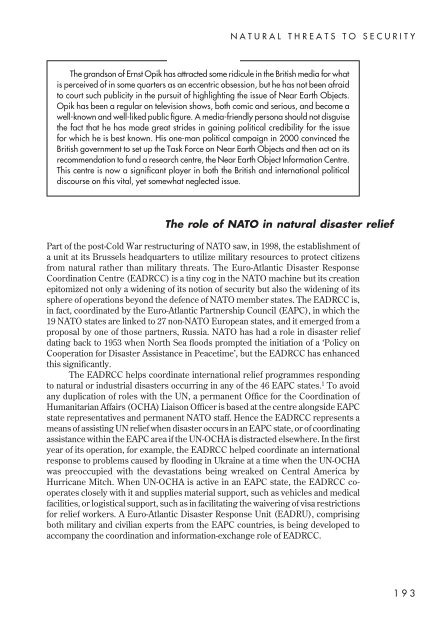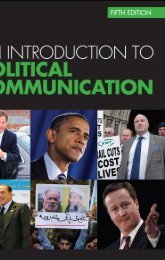Understanding global security - Peter Hough
Understanding global security - Peter Hough
Understanding global security - Peter Hough
Create successful ePaper yourself
Turn your PDF publications into a flip-book with our unique Google optimized e-Paper software.
NATURAL THREATS TO SECURITY<br />
The grandson of Ernst Opik has attracted some ridicule in the British media for what<br />
is perceived of in some quarters as an eccentric obsession, but he has not been afraid<br />
to court such publicity in the pursuit of highlighting the issue of Near Earth Objects.<br />
Opik has been a regular on television shows, both comic and serious, and become a<br />
well-known and well-liked public figure. A media-friendly persona should not disguise<br />
the fact that he has made great strides in gaining political credibility for the issue<br />
for which he is best known. His one-man political campaign in 2000 convinced the<br />
British government to set up the Task Force on Near Earth Objects and then act on its<br />
recommendation to fund a research centre, the Near Earth Object Information Centre.<br />
This centre is now a significant player in both the British and international political<br />
discourse on this vital, yet somewhat neglected issue.<br />
The role of NATO in natural disaster relief<br />
Part of the post-Cold War restructuring of NATO saw, in 1998, the establishment of<br />
a unit at its Brussels headquarters to utilize military resources to protect citizens<br />
from natural rather than military threats. The Euro-Atlantic Disaster Response<br />
Coordination Centre (EADRCC) is a tiny cog in the NATO machine but its creation<br />
epitomized not only a widening of its notion of <strong>security</strong> but also the widening of its<br />
sphere of operations beyond the defence of NATO member states. The EADRCC is,<br />
in fact, coordinated by the Euro-Atlantic Partnership Council (EAPC), in which the<br />
19 NATO states are linked to 27 non-NATO European states, and it emerged from a<br />
proposal by one of those partners, Russia. NATO has had a role in disaster relief<br />
dating back to 1953 when North Sea floods prompted the initiation of a ‘Policy on<br />
Cooperation for Disaster Assistance in Peacetime’, but the EADRCC has enhanced<br />
this significantly.<br />
The EADRCC helps coordinate international relief programmes responding<br />
to natural or industrial disasters occurring in any of the 46 EAPC states. 1 To avoid<br />
any duplication of roles with the UN, a permanent Office for the Coordination of<br />
Humanitarian Affairs (OCHA) Liaison Officer is based at the centre alongside EAPC<br />
state representatives and permanent NATO staff. Hence the EADRCC represents a<br />
means of assisting UN relief when disaster occurs in an EAPC state, or of coordinating<br />
assistance within the EAPC area if the UN-OCHA is distracted elsewhere. In the first<br />
year of its operation, for example, the EADRCC helped coordinate an international<br />
response to problems caused by flooding in Ukraine at a time when the UN-OCHA<br />
was preoccupied with the devastations being wreaked on Central America by<br />
Hurricane Mitch. When UN-OCHA is active in an EAPC state, the EADRCC cooperates<br />
closely with it and supplies material support, such as vehicles and medical<br />
facilities, or logistical support, such as in facilitating the waivering of visa restrictions<br />
for relief workers. A Euro-Atlantic Disaster Response Unit (EADRU), comprising<br />
both military and civilian experts from the EAPC countries, is being developed to<br />
accompany the coordination and information-exchange role of EADRCC.<br />
193
















